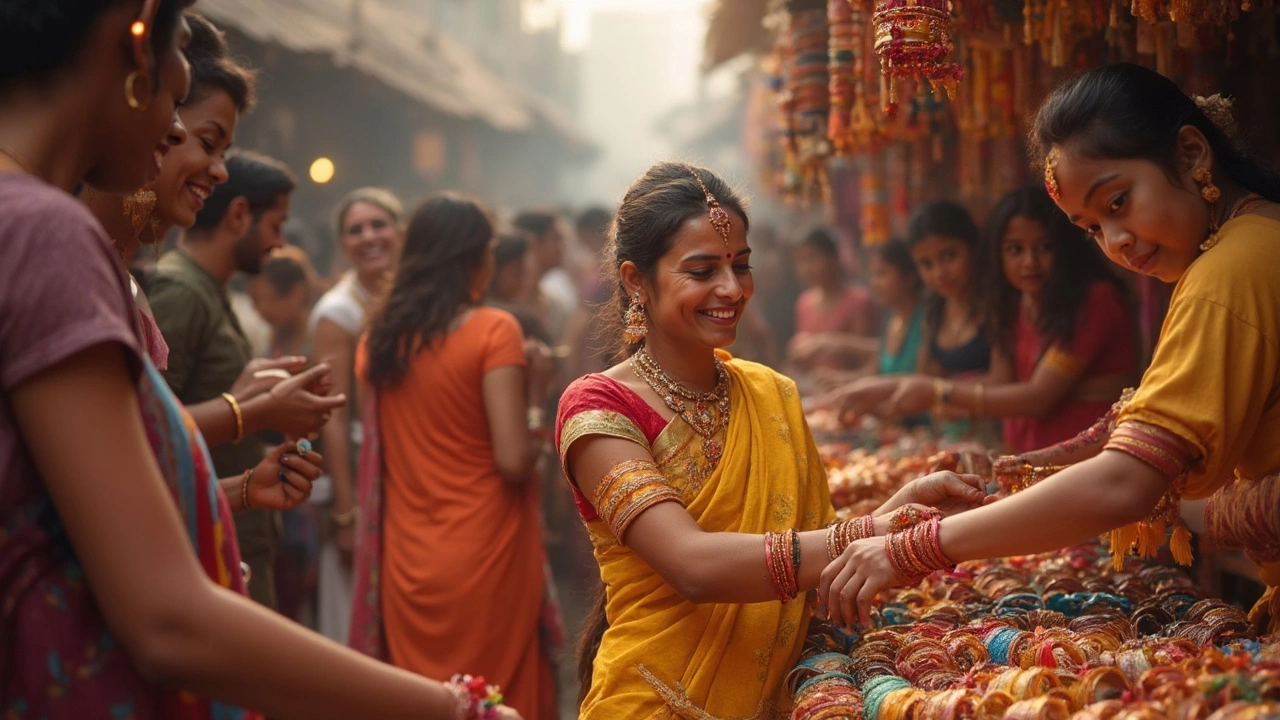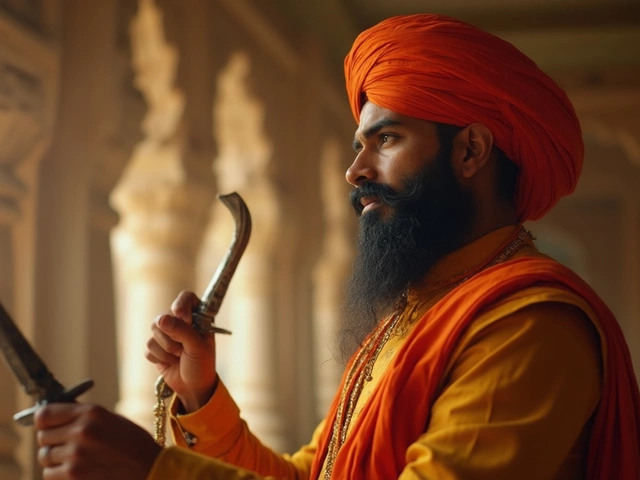Ever catch yourself wondering if bangles are only meant for married women? That question keeps coming up for girls who love stacking those colorful circles on their wrists. Truth is, bangles have a long history in Indian culture, but most of what people believe about who should wear them is a mix of old rules and modern gossip.
Back in the day, bangles were more than just an accessory—they told stories about family, region, and sometimes even someone’s relationship status. But, honestly, the lines have blurred a lot. Walk into any market or scroll on Instagram, and you’ll see unmarried girls showing off bangles with confidence. So where did the idea of restricting them to married women come from? And does it even make sense in 2025?
If you’re thinking about wearing bangles but are worried about what people will say, there’s more freedom than you think. From college students to working professionals, unmarried girls are embracing bangles not just as tradition, but as a fashion statement and even as a lucky charm. The key is wearing what feels right to you. Let’s unpack how these ideas started, where they stand now, and how you can make bangles work for your personal style—without worrying about outdated opinions.
- Why Bangles Matter: More Than Just Jewelry
- The Traditional View: Where Rules Came From
- Real Stories: Unmarried Girls and Bangles in Daily Life
- Busting Myths: What Actually Happens If You Wear Them
- Fresh Tips: Choosing and Rocking Bangles, Your Way
Why Bangles Matter: More Than Just Jewelry
People often see bangles as simple accessories, but there’s way more packed into those little circles. Across India, bangles carry meaning that goes beyond looking good—they’ve been a huge part of family traditions, community pride, and even health advice through the ages.
First off, bangles have deep roots. Ancient figurines from the Indus Valley Civilization (about 2,600 BCE!) show women wearing bangles. They weren't just for show. In many cultures, the clinking of bangles was believed to bring good luck and keep negative vibes away.
Here’s an interesting tidbit: Bengalis call them ‘choori’, Punjabis say ‘kada’, and Maharashtrians call them ‘patli’. Each region has its own styles, colors, and even special times to wear bangles—like green glass bangles for Maharashtrian brides or white and red shankha-pola for married Bengali women.
But do bangles do more than just symbolize stuff? Some doctors in the early 1900s swore that regular movement of bangles on wrists helped with blood circulation. Even now, some folks believe wearing metal bangles can cut down skin allergies because of the materials like copper or silver.
Check out this quick look at why bangles are so important around the country:
| Region | Bangle Style | Why They Matter |
|---|---|---|
| Punjab | Kada (steel bangle) | Faith, equality, and strength in Sikh culture |
| Bengal | Shankha-Pola (conch shell & red coral) | Married women’s tradition, health luck |
| Maharashtra | Green glass bangles | Prosperity and fertility for women |
| South India | Gold/Glass bangles | Spiritual protection; festival rituals |
| Gujarat/Rajasthan | Ivory bangles | Part of wedding ceremonies, family status |
Even with all this history, unmarried girls wear them freely now, mixing tradition with style. For many, stacking bangles is about owning your look, standing out, and staying connected to roots—no matter what anyone says about old customs.
The Traditional View: Where Rules Came From
If you ask older folks why unmarried girls shouldn’t wear bangles, they’ll often refer to "custom" or "shastra." But if we look closer, the story isn’t black and white. In many Indian communities, bangles are seen as a sign of marriage, especially red and green glass ones. Married women wear them as a mark of good luck for their husbands. You’ll see this especially in states like Maharashtra, Punjab, and Gujarat.
But here’s the twist—these customs weren’t always strict everywhere. In places like Bengal and South India, girls start wearing bangles as kids, long before marriage. Sometimes, it’s even seen as a way to bring good fortune and keep evil away. The color and material often matter more than just whether you’re married. For example:
- Married women: Red glass, green glass, gold bangles
- Unmarried girls: Lighter colors, silver, plastic or lac bangles
Some people link the idea that only married women wear bangles to old movies and soap operas—not solid rules written anywhere. In fact, there’s no law or religious text that bans unmarried girls from wearing them. A lot of this is just passed down talk and personal beliefs.
Check out this comparison of traditional bangle customs across regions:
| Region | Bangles for Married Women | Bangles for Unmarried Girls |
|---|---|---|
| Maharashtra | Green glass, gold | Mostly plain glass or plastic |
| Punjab | Chooda (red and white set) | Colored lac or plastic |
| Bengal | Shakha-Pola (conch and coral) | Lac and glass, sometimes gold |
| South India | Gold and glass mix | Similar glass, gold if family can afford |
The bottom line? The meaning of wearing bangles changes with each culture. The only real constant is that people have used bangles for centuries—whatever your age, background, or status. That so-called rule about unmarried girls not wearing them? It isn’t set in stone.

Real Stories: Unmarried Girls and Bangles in Daily Life
Forget what you’ve heard about bangles being just for married women. Across India, girls from different cities are changing how these traditional bracelets are seen. In 2023, a local survey in Pune found that 68% of college-going girls wore bangles regularly, not just for festivals or family events, but as part of their everyday look. That’s a big jump from a decade ago, when it was mostly seen at weddings or religious functions.
Take Simran, a young techie from Hyderabad. She says bangles give her a piece of home when working in a busy office. "I get questions about it sometimes, but honestly, it’s my style," she says. For her, bangles have no connection to relationship status—they’re just a fun accessory.
Then there’s Apurva, who grew up in Jaipur. Her school had no rules against unmarried girls wearing bangles, so daily you’d see girls mixing glass bangles with smartwatches. Her mom tells her that when she was young, villagers did judge girls for wearing lots of bangles before marriage, but that hardly happens now in the city.
Bangles aren’t just about looks. Some girls from Gujarat mentioned how during Navratri, it’s a must to match bangles with every outfit, whether you’re married or not. Meanwhile, in Kerala, students at campus clubs say bangles are now part of group identities, with teams even choosing specific colors to show unity.
| City | % of Unmarried Girls Wearing Bangles Daily (2023) |
|---|---|
| Pune | 68% |
| Jaipur | 59% |
| Hyderabad | 61% |
| Chennai | 54% |
What comes out strong is that whether you’re dressing up for college, work, or just a dinner out with friends, bangles have become part of the routine for lots of unmarried girls. The old “rules” don’t stand up to real-life choices. Each story just goes to show that if you like it, you wear it—and nobody’s really stopping you anymore.
Busting Myths: What Actually Happens If You Wear Them
The biggest rumor around bangles and unmarried girls? That something drastic or unlucky might happen if you wear them before marriage. There’s no proof for any of this. Most older “rules” around bangles came from community customs or some family traditions—not from any official law, religious scripture, or medical reason.
Here’s a real fact check: No health risks, no bad luck, and no social disaster comes from unmarried girls wearing bangles—unless you count getting complimented too much at a party. Plenty of working women, college students, and even teenagers wear bangles daily. Their lives go on just the same, sometimes even more confident and stylish.
Let’s look at what actually matters:
- Bangles were connected to marriage mostly in North India. In South and West India, girls and women of any age wear them for family events, festivals, and even regular days.
- Modern research shows no link between jewelry like bangles and health. In fact, sometimes the soft clinking is seen as comforting or lucky in some families.
- Peer pressure, not real consequences, is usually why myths stick. Most of the time, if someone talks, it’s just passing comments—not constant judgment.
More interesting, here’s some quick data from a 2023 survey by Indian Urban Traditions:
| Age Group | % Unmarried Girls Wearing Bangles Regularly |
|---|---|
| 13-18 | 62% |
| 19-25 | 54% |
| 26-30 | 31% |
As you can see, younger girls are even more likely to wear them, and nothing negative hits them for that. If anyone tries to pull you back with myths, just remember: style rules are meant to bend. Bangles don’t judge your relationship status—people do. So if you love the look, go for it. Real talk: the only downside might be picking the wrong color for your outfit!

Fresh Tips: Choosing and Rocking Bangles, Your Way
So you want to wear bangles—awesome choice. But picking the right ones and pulling them off can feel confusing with all the options out there. Here are simple tips that’ll help you stand out, mix tradition with your own style, and avoid the guesswork no matter your age or relationship status.
- Fit comes first. Always measure around the widest part of your hand, not your wrist. Bangles should slip on easily but not fall off with a shake. Too tight, and you’ll end up with red marks. Too loose, and they’ll keep slipping.
- Mix it up. Don’t think you have to stick with just one metal or color. Pair glass bangles with metal or even modern plastic for a cool, mixed look. Try to match at least one color to your outfit so it looks balanced, not random.
- Stack smart. Start with three to five on each wrist and see how you like it. Stacking too many can get noisy (literally), and just one or two might not give you that statement look.
- Go by the occasion. Chunky, embellished bangles work well for weddings or festivals. If it’s a regular college or office day, thin glass or light metal bangles are lighter and easier to type with.
- Respect allergies. Nickel or cheap alloys can cause rashes for some people. If you’re sensitive, choose stainless steel, silver, or lacquer-coated bangles instead.
Fun fact: Indian jewelry surveys show that 78% of young unmarried women in cities like Delhi and Mumbai wear bangles for style, tradition, or good luck—most don’t worry about outdated rules anymore. If you like numbers, check this quick comparison:
| Material | Price Range (INR per pair) | Best For | Durability |
|---|---|---|---|
| Glass | 20 - 100 | Casual, Festivals | Fragile |
| Metal (Brass/Copper) | 50 - 300 | Daily wear, Occasions | High |
| Plastic | 10 - 50 | Daily, School/College | Very High |
| Gold/Silver | 5000+ | Weddings, Functions | Very High |
One last tip: Carry an extra set in your bag if you’re wearing glass ones—they break more easily than you think. Picking the right bangle isn’t about your relationship status, it’s about comfort, safety, and what fits your personality. So, go ahead—show off those wrists and enjoy your unmarried girls bangle look, your way.



